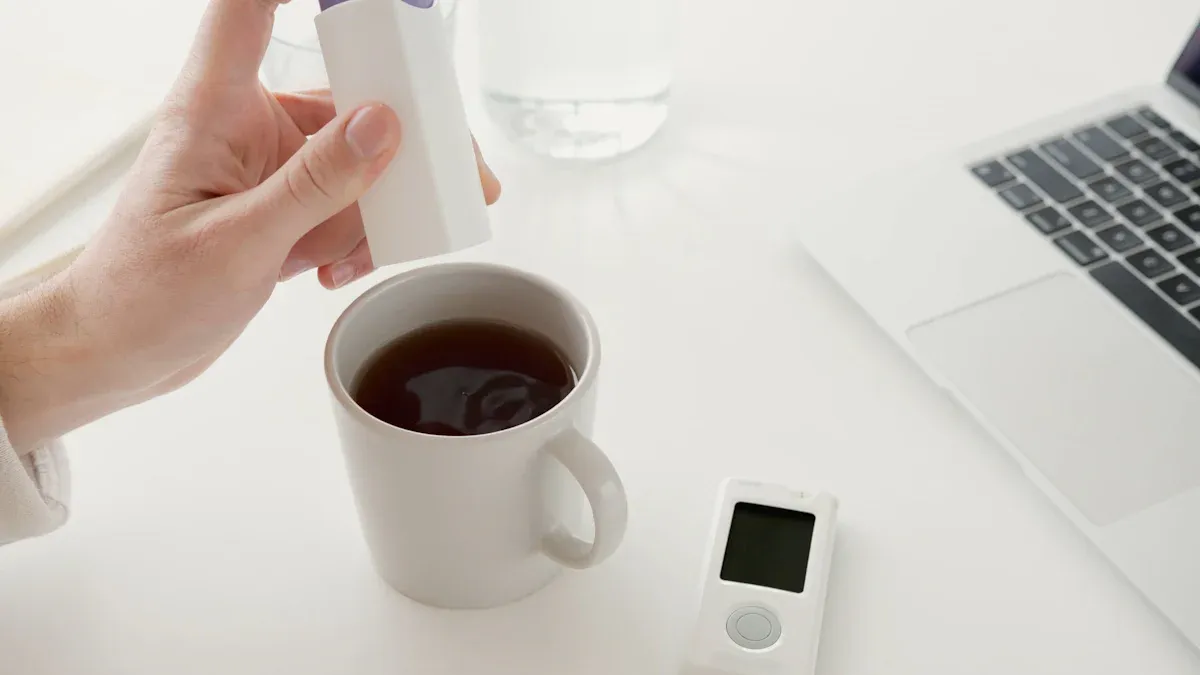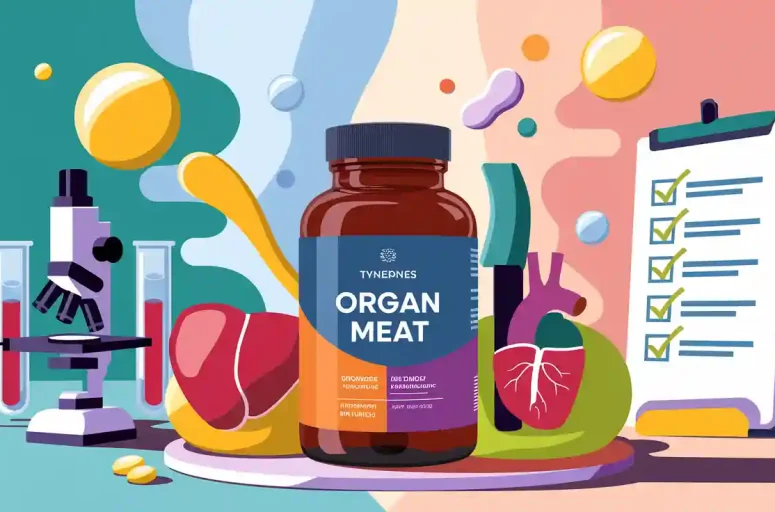
If you want a natural way to help type 2 diabetes, green tea could help due to its numerous green tea benefits. It contains strong compounds called catechins, like EGCG, which assist your body in using insulin more effectively. Research shows it can lower fasting blood insulin by 1.30 U/L, making it easier to control your blood sugar levels. Drinking green tea regularly is not just beneficial for diabetes; it also offers many health benefits for your body. Why not start enjoying its green tea benefits today?
Key Takeaways
Green tea has catechins, like EGCG, that help with insulin and lower blood sugar.
Drinking green tea often can lower fasting insulin, helping control blood sugar.
Fixing insulin resistance is key for managing type 2 diabetes and avoiding problems.
Switching from sugary drinks to green tea can cut diabetes risk and boost health.
Drink three to five cups of green tea daily for better blood sugar control.
Make green tea right for the best taste and benefits; don’t use boiling water and steep for 2-3 minutes.
Check your blood sugar when adding green tea, as it can lower it a lot.
Talk to your doctor before changing your diabetes plan, especially with green tea.
Understanding Insulin Resistance and Its Role in Type 2 Diabetes
What Is Insulin Resistance?
Insulin resistance happens when your body’s cells don’t use insulin well. Insulin is a hormone that moves sugar from your blood into cells. Your cells use this sugar for energy. When cells resist insulin, sugar stays in your blood instead of going into cells. Over time, this can cause high blood sugar levels.
Imagine insulin as a key and your cells as locked doors. Normally, the key opens the door to let sugar in. With insulin resistance, the key doesn’t work properly. The door stays closed, and sugar builds up in your blood. This problem develops slowly and can lead to type 2 diabetes if not managed.
Why Improving Insulin Resistance Matters for Type 2 Diabetes
Fixing insulin resistance is very important for managing type 2 diabetes. When cells respond better to insulin, your body controls blood sugar more easily. This lowers the chance of problems like nerve damage, kidney disease, or heart issues.
Studies show improving insulin resistance helps your health in many ways:
Green tea can lower fasting blood sugar levels (SMD = -0.41, P = .001).
It also reduces glycated hemoglobin, which tracks long-term blood sugar (SMD = -0.68, P = .004).
The insulin resistance index also improves greatly (SMD = -0.70, P = .005).
These results show how better insulin resistance helps control blood sugar and eases stress on your body. Small changes, like drinking green tea daily, can help you manage diabetes better.
Tip: Try simple steps, like drinking green tea every day. Small habits can improve insulin resistance and boost your health.
Green Tea Benefits for Insulin Sensitivity
How Green Tea Helps with Insulin Resistance
Green tea can help your body handle insulin resistance better. Drinking it often makes your cells respond to insulin more easily. This helps move sugar from your blood into your cells, keeping blood sugar steady. For people with type 2 diabetes, this can be life-changing.
Studies show green tea helps your muscles absorb sugar better. This lowers insulin resistance and improves blood sugar control. A review of 17 studies found green tea linked to better blood sugar levels and lower fasting insulin.
Here’s what research says about green tea and insulin resistance:
Study Type | Findings |
|---|---|
Experimental Studies | Green tea helps muscles absorb sugar, improving insulin sensitivity. |
Animal Studies | Green tea extract lowers blood sugar and reduces insulin resistance in diabetic mice. |
Meta-Analysis | 17 studies show green tea improves blood sugar and lowers fasting insulin. |
Switching from sugary drinks to green tea can reduce your diabetes risk. It’s a small change that can improve your health.
Tip: Replace one sugary drink daily with green tea. Small changes can help manage diabetes.
How Catechins Improve Insulin Sensitivity
Catechins are strong compounds in green tea that help with insulin sensitivity. Epigallocatechin gallate (EGCG) is the most helpful. It lowers inflammation and stress, which cause insulin resistance.
Catechins make your body use insulin better to control blood sugar. Studies on diabetic mice show green tea extract with catechins lowers blood sugar and improves insulin resistance. These results show how catechins help manage type 2 diabetes.
A 2017 review said green tea has many benefits, but results vary. Genetics and tea leaf types may affect how well it works. Still, green tea’s polyphenols, like EGCG, are a natural way to support health.
If you want a natural way to manage diabetes, try green tea. Its catechins improve insulin use and offer other benefits, like reducing inflammation and boosting metabolism.
Note: Use good-quality tea leaves and skip sugar for the best benefits.
Scientific Evidence on Green Tea and Type 2 Diabetes
Key Studies Highlighting Green Tea’s Benefits
Does green tea really help with type 2 diabetes? Science says yes! Many studies show green tea improves insulin resistance and controls blood sugar. A review found people drinking green tea had better fasting blood sugar, glycated hemoglobin (a long-term blood sugar marker), and insulin resistance. These changes were significant, meaning they weren’t random.
One study compared two groups of people with type 2 diabetes. The group drinking green tea had better blood sugar control. They also showed a big drop in insulin resistance, with an effect size of -0.70. This proves green tea can make a real difference in your health.
Animal studies agree with this. In tests with rats eating high-fat diets, green tea improved how their bodies used sugar. It even changed genes linked to metabolism. This shows green tea works deep inside the body, not just on the surface.
Tip: Drinking green tea daily is a simple way to improve your health if you have diabetes.
Mechanisms Behind Green Tea’s Effect on Blood Sugar and Inflammation
How does green tea help? Its secret is in its powerful compounds, especially catechins like EGCG. These compounds fight the main causes of insulin resistance and high blood sugar. They lower inflammation and oxidative stress, which are big problems in diabetes.
Here’s what studies say about green tea’s effects:
It lowers fasting blood sugar (SMD = -0.41, P = .001).
It reduces glycated hemoglobin (SMD = -0.68, P = .004).
It improves insulin resistance (SMD = -0.70, P = .005).
These numbers mean real health improvements. Green tea helps your body use insulin better, keeping blood sugar steady. It also helps your cells absorb sugar for energy, improving glucose metabolism.
Green tea does even more. It changes body composition and improves how your body handles sugar. This reduces stress on your pancreas and lowers the risk of complications. Whether you want to manage or prevent type 2 diabetes, green tea is a natural way to stay healthy.
Note: Use good-quality green tea and skip sugar for the best benefits.
Practical Tips for Adding Green Tea to Your Day
How Much Green Tea Should You Drink?
Drinking green tea can help manage type 2 diabetes. But how much is enough? Experts suggest having three to five cups daily. This equals about 24 to 40 ounces. This amount helps improve insulin use and keeps blood sugar steady.
Some studies say adults can handle up to 24 cups a day. But drinking that much isn’t a good idea. Too much green tea can cause jitteriness or upset your stomach because of the caffeine. Start with a small amount and see how you feel.
For the best benefits, drink green tea plain. Don’t add sugar or milk, as they can reduce its helpful effects. Keeping it simple ensures you get the most out of this healthy drink.
Tip: Begin with one cup in the morning. Slowly increase to three or four cups a day.
How to Brew Green Tea Correctly
Making green tea the right way improves its taste and benefits. Follow these steps:
Use fresh, good-quality tea leaves or tea bags for better flavor.
Heat water to 160–180°F. Don’t let it boil, as boiling water can make the tea bitter and less effective.
Steep the tea for 2–3 minutes. Steeping too long can also make it taste bitter.
If you’re new to green tea, try different types like matcha or sencha. Find one you enjoy so drinking it feels pleasant, not like a chore.
Note: Skip adding sugar or artificial flavors. Keeping it natural gives the best results.
Watch for Side Effects and Other Concerns
Green tea is healthy, but it can have side effects. Its caffeine may cause restlessness, headaches, or stomach upset if you drink too much. If you’re sensitive to caffeine, try decaf green tea or limit yourself to one or two cups daily.
Green tea might also affect some medicines, like those for diabetes or blood pressure. Talk to your doctor before adding green tea to your diet. They can help adjust your treatment if needed.
Remember, green tea is not a cure. It works best with a healthy lifestyle. Eat balanced meals, exercise, and follow your doctor’s advice to manage type 2 diabetes effectively.
Reminder: Pay attention to how your body reacts. If green tea causes any problems, drink less or talk to a doctor.
Additional Green Tea Benefits for Type 2 Diabetes
Helping with Weight and Metabolism
Green tea can help you manage weight and boost metabolism. This is especially useful for people with type 2 diabetes. It has natural compounds like catechins and caffeine. These work together to burn more calories and fat. Your body uses fat as energy, helping you stay at a healthy weight.
Studies show green tea lowers fasting blood sugar and glycated hemoglobin. These are important for controlling diabetes. By improving metabolism, green tea helps your body handle sugar better. This lowers the chance of getting diabetes and makes blood sugar easier to control.
Tip: Combine green tea with healthy eating and exercise. Small changes can improve your health.
Supporting Heart Health
Green tea is great for your heart. People with diabetes often have a higher risk of heart problems. Green tea’s catechins, which are antioxidants, reduce inflammation and improve blood flow. This helps your blood vessels work better and lowers heart disease risks.
Research shows green tea reduces fasting blood sugar and improves insulin resistance. These benefits ease stress on your heart and blood vessels. Drinking green tea daily is a simple way to keep your heart healthy.
Note: Use good-quality green tea for the best results. Don’t add sugar, as it reduces its benefits.
Fighting Free Radicals for Better Health
Green tea is full of antioxidants that protect your body from harm. Free radicals can cause inflammation, aging, and diseases like diabetes. Green tea fights these harmful molecules, reducing inflammation and improving overall health.
Its antioxidants may also lower the risk of cancer, heart disease, and memory loss. Catechins and caffeine in green tea boost energy and burn fat. This keeps your metabolism strong and helps you feel active all day.
Did you know? Green tea helps with diabetes and supports long-term health. A small habit can bring big benefits.
Comparing Green Tea to Other Natural Remedies
Green Tea vs. Herbal Teas for Insulin Resistance
Green tea is often the best choice for insulin resistance. But how does it compare to other herbal teas? Green tea has special compounds called catechins, like EGCG, that help your body use insulin better. These compounds also reduce inflammation, keeping blood sugar levels steady.
Here’s a comparison of green tea and sour tea for insulin resistance:
Outcome Measure | Green Tea (GT) | Sour Tea (ST) | P-Value |
|---|---|---|---|
8.5 to 6.6 μIU/mL | 8.2 to 16.3 μIU/mL | 0.004 | |
HOMA-IR | 1.1 | 1.6 | 0.004 |
HDL-c | Increased | Increased | N/A |
Body Fat Percentage (b%) | N/A | Increased from 38.2% to 47.7% | N/A |
S% | N/A | Decreased | N/A |
Green tea lowers fasting insulin and improves insulin resistance better than sour tea. Sour tea may even increase body fat. If you want the best tea for insulin resistance, green tea is the clear winner.
Tip: Pick green tea over other herbal teas for better blood sugar control and health.
Green Tea and Dietary Supplements
Green tea is more than just a drink—it’s packed with health benefits. When combined with dietary supplements, its effects on insulin resistance can improve even more. For example, supplements with EGCG, a key compound in green tea, show great results. In diabetic mice, EGCG improved insulin sensitivity and prevented glucose problems. This shows green tea compounds work well with supplements to manage blood sugar.
Here’s what research says about green tea and supplements:
Study Type | Findings | Population | Conclusion |
|---|---|---|---|
Meta-analysis of 17 RCTs | GT/GTE consumption improved glycemic control and reduced fasting insulin concentration | Healthy subjects, individuals with obesity, CVD, cancer, T2DM | Supports the role of GT in enhancing insulin sensitivity |
Animal studies also support this:
Green tea extract (GTE) lowers blood sugar and reduces insulin resistance in diabetic mice.
Rats given 23 g of GTE daily had higher insulin levels, which may help prevent type 2 diabetes.
If you’re thinking about supplements, choose ones with green tea extract or EGCG. These can boost your diet and help manage insulin resistance.
Note: Talk to your doctor before adding supplements, especially if you have diabetes.
Combining Green Tea with a Balanced Diet
Drinking green tea is helpful, but pairing it with a healthy diet makes it even better. A diet with whole grains, lean proteins, and vegetables helps control blood sugar. Adding green tea to this mix creates a strong plan for managing type 2 diabetes.
Studies show green tea and a balanced diet together improve blood sugar control. Key findings include:
Fasting blood glucose: SMD = -0.41, 95% CI: -0.67 to -0.19, P = .001
Glycated hemoglobin: SMD = -0.68, 95% CI: -1.15 to 0.21, P = .004
Insulin resistance index: SMD = -0.70, 95% CI: -1.18 to -0.22, P = .005
These results show how green tea and healthy eating work together to lower blood sugar and insulin resistance. For the best results, eat nutrient-rich foods and drink green tea daily.
Tip: Swap sugary drinks for green tea at meals. It’s an easy way to stay healthy and enjoy a tasty drink.
Consulting Your Healthcare Provider
Watching Blood Sugar Levels with Green Tea
When you start drinking green tea often, check your blood sugar. Green tea helps your body use insulin better, which can lower blood sugar. This is helpful for diabetes, but you must watch for sudden drops in sugar levels.
Your doctor can tell you how often to test your blood sugar. They may ask you to write down your fasting blood sugar numbers. This helps you and your doctor see how green tea affects your body.
Take charge of your health—talk to your doctor about using green tea. Together, you can make safe and smart choices.
Changing Medications or Treatment Plans
Green tea can improve blood sugar control, which might change your medicine needs. Studies show it lowers fasting blood sugar, glycated hemoglobin, and insulin resistance. These changes are important and could affect your treatment plan.
Key findings include:
Green tea helps people with type 2 diabetes manage blood sugar.
It lowers fasting blood sugar (SMD = -0.41, P = .001).
It reduces glycated hemoglobin (SMD = -0.68, P = .004).
It improves insulin resistance (SMD = -0.70, P = .005).
If you take diabetes medicine, these changes might mean adjusting doses. Your doctor can guide you safely. Never stop or change your medicine without asking your doctor first.
Considering Personal Health Needs
Green tea works differently for everyone. While it helps with diabetes, it may not work the same for all. Your health, other conditions, or genetics can change how green tea affects you.
Here’s what research says:
Findings | Description |
|---|---|
Glycemic Control | Green tea compounds help lower blood sugar and improve insulin resistance. |
Inconsistency | Research results on green tea and blood sugar control vary. |
Clinical Practice | Studies give useful tips for managing diabetes with green tea. |
If you have health concerns, ask your doctor before adding green tea. They can help decide if it’s right for you and fits your diabetes care plan.
Reminder: Pay attention to your body. If green tea causes unusual symptoms, tell your doctor quickly.
Green tea is an easy and helpful way to manage type 2 diabetes. It has natural compounds, like catechins, that lower insulin resistance and balance blood sugar. This makes it a useful choice for controlling diabetes. It also helps your heart and boosts metabolism.
Even though green tea is beneficial, talk to your doctor first. They can help you use it safely and make it part of your diabetes care plan.
Tip: Swap one sugary drink for green tea each day. It’s a simple step to better health.
FAQ
1. Can green tea cure type 2 diabetes?
No, green tea can’t cure type 2 diabetes. It helps improve insulin sensitivity and supports blood sugar control. Think of it as a helpful addition to your routine, not a replacement for medications or a healthy lifestyle.
Tip: Always follow your doctor’s advice for managing diabetes.
2. How soon will I see results from drinking green tea?
Results vary for everyone. Some people notice better blood sugar control within weeks, while others may take longer. Consistency is key. Drink green tea daily and pair it with healthy habits for the best outcomes.
3. Is matcha better than regular green tea for diabetes?
Matcha contains more catechins and antioxidants than regular green tea. This makes it a stronger option for improving insulin sensitivity. However, both types offer great benefits, so choose the one you enjoy most.
4. Can I drink green tea if I’m on diabetes medication?
Yes, but you should talk to your doctor first. Green tea can lower blood sugar, which might affect your medication dosage. Monitoring your blood sugar levels is essential when adding green tea to your routine.
5. Does green tea have caffeine? Is it safe for everyone?
Yes, green tea contains caffeine, but less than coffee. Most people tolerate it well. If you’re sensitive to caffeine, try decaf green tea. Pregnant women or those with certain conditions should consult their doctor before drinking it.
6. What’s the best time to drink green tea for diabetes?
You can drink green tea any time of day. Many people prefer it in the morning or between meals. Avoid drinking it late at night, as the caffeine might disrupt your sleep.
7. Are there any side effects of drinking green tea?
Drinking too much green tea can cause headaches, upset stomach, or jitteriness due to caffeine. Stick to 3–5 cups daily. If you notice any discomfort, reduce your intake or consult your doctor.
8. Can I sweeten my green tea?
It’s best to avoid adding sugar or sweeteners, as they can spike blood sugar levels. If you need sweetness, try a natural option like a small amount of stevia. Keeping it plain ensures maximum health benefits.
Note: Plain green tea is the healthiest choice for managing diabetes.


